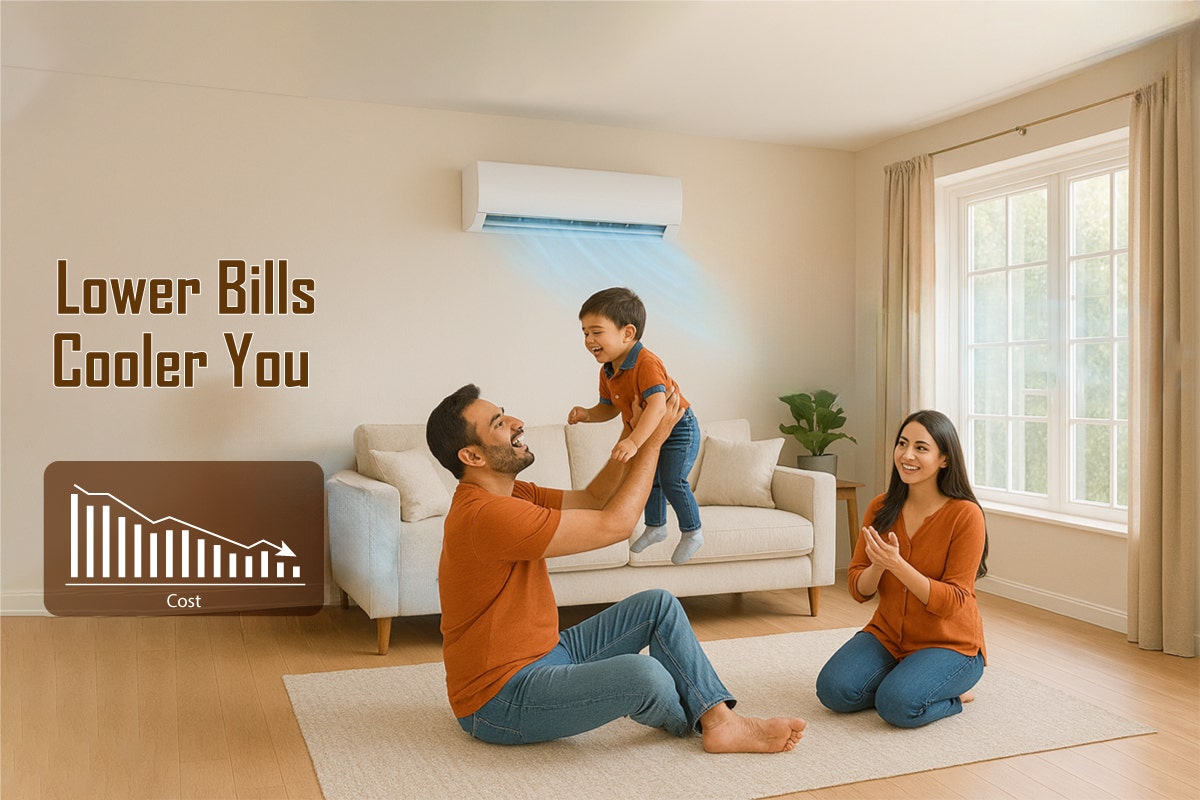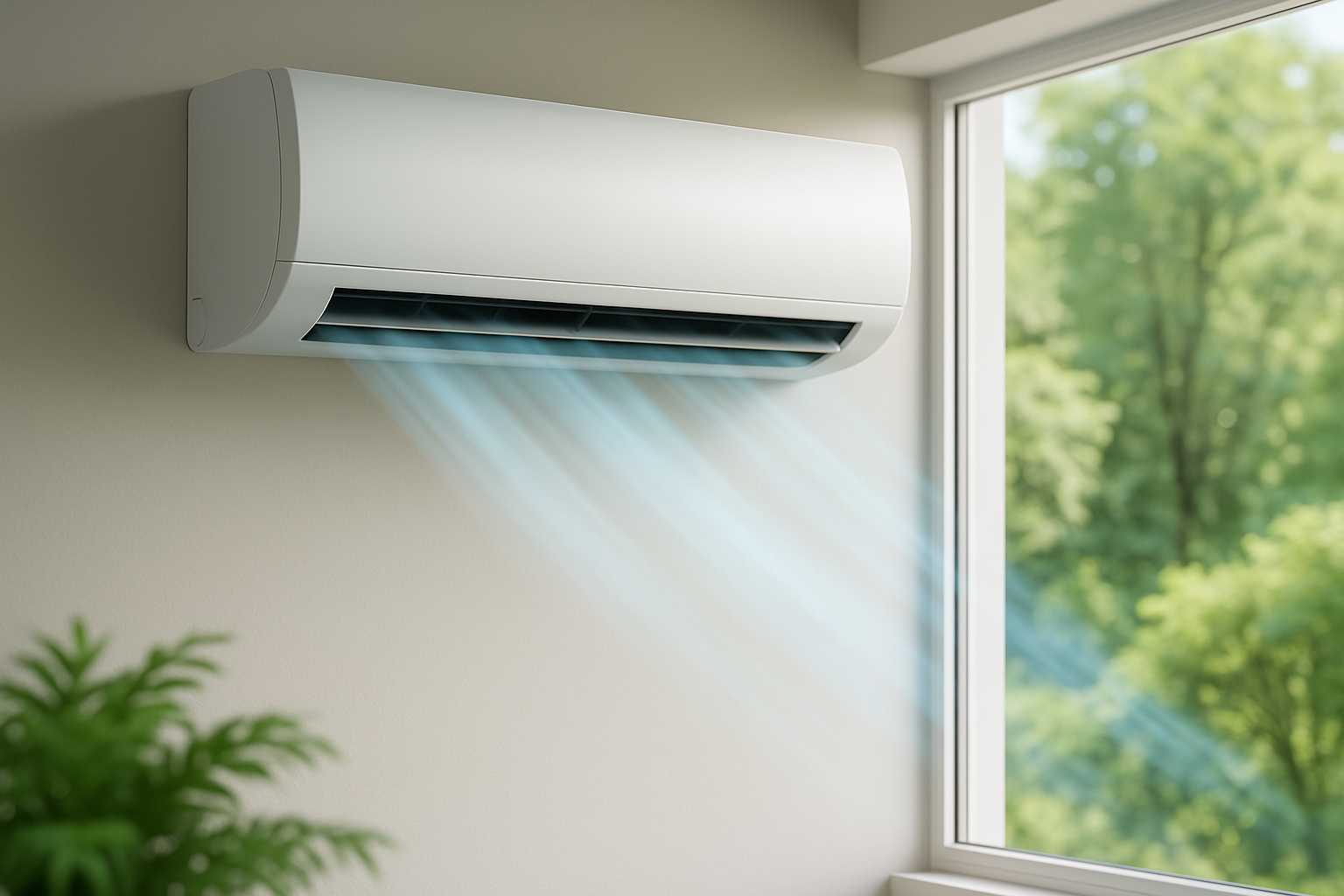Myths vs. Facts: The Truth About Energy-Efficient Air Conditioners


High-efficiency air conditioner? Check. Electricity bill still sky-high? Also check.
If this sounds familiar to your condition, then you're not alone. Many homeowners and renters invest in energy-efficient air conditioners and expect a dramatic drop in electricity bills.
However, they often fail to notice that owning a high-efficiency AC doesn’t automatically guarantee lower costs. That’s just one of the common energy-saving AC myths, not a real scenario.
In a world where energy-efficient air conditioners are more important than ever for the environment and wallet, it’s high time to separate AC efficiency facts from myths.
In this article, we’ll break down the most widespread myth vs. reality of energy-efficient AC. Therefore, let’s clear the air literally and financially!
What Are Energy-Efficient Air Conditioners?
Energy-efficient air conditioners are designed to provide effective cooling while using less electricity. It makes them both cost-saving and environmentally responsible.
Unlike traditional air conditioners that use a lot of power, energy-saving AC uses advanced technology to lower energy use without losing performance.
Here are the key criteria that make an AC energy efficient-
Let’s understand what really makes your AC energy efficient:
1. High EER Rating
EER (Energy Efficiency Ratio) measure how efficiently an AC converts electricity into cooling.
A higher EER = more cooling per watt of electricity.
EER is more accurate for consistently hot climates countries like Bangladesh.
2. Inverter Technology
Traditional ACs work in an on/off cycle. Inverter ACs use variable-speed compressors that ramp up or down as low as 10 Hz based on cooling demand.
This reduces power surges and wasted energy, especially during partial loads.
Inverter ACs are up to 60–70% more efficient in many conditions compared to fixed-speed models.
3. Efficient Compressor Design
Modern energy-efficient ACs often feature rotary or scroll compressors that are quieter and consume less power.
Compressors like twin rotary or dual inverter models offer improved control and less vibration.
4. Refrigerant Type
Eco-friendly refrigerants like R-32 or R-410A (instead of outdated R-22) contribute to better heat transfer and lower global warming potential.
R-32 is especially efficient due to its:
· Lower viscosity
· Better thermodynamic properties
· Smaller charge requirement
5. Smart Thermostat & Sensors
ACs with smart thermostats or occupancy sensors optimize cooling based on real-time room conditions.
They prevent overcooling and reduce energy waste.
Some models even use AI-based climate control (Machine learning algorithm) to learn your usage patterns.
6. High-Efficiency Heat Exchangers
Larger surface area in the evaporator and condenser coils improves heat transfer.
Microchannel coils and grooved copper tubes are more efficient in exchanging heat with less refrigerant.
7. Better Insulation & Sealing
Energy-efficient units are designed with:
· Double-insulated panels
· Tightly sealed ducts and cases
· Anti-corrosion coating on the evaporator to maintain performance over time
8. Low Standby Power Consumption
Advanced units draw minimal power in standby mode (some <1W).
Standby savings matter over time, especially in homes where ACs remain plugged in year-round.
9. Energy Star Certification
Energy Star-rated ACs meet or exceed government efficiency standards.
These models undergo third-party testing and often include features like programmable thermostats, eco mode, turbo cool, and advanced diagnostics.
Myth vs Facts About Air Conditioners
Let's discuss some myths about Air Conditioners and know the facts-
Myth #1: Inverter ACs Always Use Less Electricity
Fact: Usually yes, but only when used wisely.
Inverter ACs adjust their power based on how hot the room is, rather than switching on and off like non-inverter units. This saves energy over time, especially if you run your AC for long hours. But if your room isn’t well-insulated, keep the door open or if you're constantly changing the temperature setting, you may not save as much.
Solution
Set your inverter AC at 25–26°C, and keep doors and windows closed. Check the insulation, now let it do its job steadily.
Myth #2: Energy Efficiency Equals Less Power or Cooling
Fact :
One of the most common misconceptions is that energy-efficient cooling systems compromise on cooling performance to save power. In reality, that’s not true.
Energy-efficient ACs are designed to deliver the same or even better cooling with advanced technology. Features like inverter technology, variable-speed compressors, and smart thermostats ensure consistent cooling with optimized energy consumption, without losing performance.
Solution
Look for AC units that have a high SEER rating, use inverter technology to adjust power based on need and also are appropriately sized for your room (right BTU rating).
Also, keep in mind that a properly installed and maintained energy-efficient AC will cool just as powerfully without the energy drain.
Myth #3: Turning the Thermostat Lower Cools the Room Faster
Fact:
This is one of the most common thermostat myths. Lowering the temperature to 16°C instead of 24°C won’t make your AC cool any faster. Rather, it just forces the unit to run longer and wastes energy, and increases your electricity bill.
Solution
Set your thermostat to an optimal range (24–26°C) for maximum comfort and efficiency. Consider using smart thermostats or programmable timers to maintain consistent temperatures and save energy automatically.
Myth #4: Turning Off the AC Often Saves Power
Fact: Not always — it might actually use more power.
A common myth we are entertaining over the year, that turning off your AC while the room is cooled to its desired comfort will save more electricity! Turning your AC off and on repeatedly forces it to work harder, starting current especially in humid weather. Instead, try raising the temperature or using the eco mode. Inverter models, in particular, are more efficient when they run continuously at a steady level.
Solution
Rather off and on your AC, use a timer or smart plug to manage how long the AC runs. It will save energy with smart features.
Myth #5: Any Energy-Efficient AC Will Save You Money
Fact: Only if it’s the right size and used the right way.
Energy-efficient ACs are designed to use less power, but they don’t work miracles. If you buy a unit that’s too big or too small for your room, or if it’s installed poorly, you won’t see the savings you’re expecting. It’s like buying running shoes that don’t fit — they won’t help you win the race.
Solution
Before purchase, check the room size, take a correct measurement, and find the perfect BTU (British Thermal Unit) for your home or office to enjoy the most of an energy efficient AC.
Myth #6: Energy Star Ratings Are Just for Show
Fact: They really do make a difference.
A 5-star rated AC can use up to 50% less electricity than a 1-star model, especially over months of use. These ratings are tested under standardized conditions, and while real life isn’t always perfect, they’re a solid guide to long-term efficiency.
Tip: Going for a higher star rating may cost more upfront, but it pays off over the years in lower bills.
Myth #7: My Old AC Still Works Fine, So Why Upgrade?
Fact: It may “work,” but it’s costing you big.
Older ACs can guzzle electricity, even if they seem to cool well. Newer models not only use eco-friendly refrigerants, but they also come with smart features and significantly better energy efficiency. The difference on your electricity bill can be massive.
Solution
If your AC is over 8–10 years old, consider upgrading. The savings can help cover the cost in just a few summers.
Simple Ways to Boost Air Conditioner Efficiency:
✅ Use curtains or blinds to block direct sunlight
✅ Clean your AC filters once a month
✅ Use self-cleaning feature every 15 days
✅ Seal gaps around windows and doors to keep cool air in
✅ Use ceiling fans along with the AC to circulate cool air
✅ Get a professional service every year before summer. Maintenance is the main key.
Trusted Brands Known for Energy-Efficient ACs


If you’re looking to invest in an energy-efficient air conditioner from a trusted local distributor, House of Butterfly is a great place to start.
They offer a curated selection of the best energy-efficient air conditioners in Bangladesh. Here’s a breakdown of some of the best energy-efficient AC brands like Butterfly, eco+, Haier, and LG, you can find on their platform.
1. BUTTERFLY 1.5 TON INVERTER AC
-
Up to 65% energy saving
-
Self Clean
- Eco Mode
- Turbo Cool
-
Hidden LED Display
-
Copper Condenser
-
Advanced Filtration System
-
Budget-Friendly (Around ৳ 80,000)
2. LG DUAL INVERTER 1.8 TON AC
-
Up to 70% Energy Savings
-
Hidden LED Display
-
Himalaya Cool/Jet Cool
-
Gold Fin (CU) Condenser
-
High Voltage Protection
-
Expensive in price but worth it in the long term (Around ৳1,50,000)
3. ECO+ 2 TON INVERTER AC
-
Up to 60% energy saving
-
Gold Fin
-
Cooper Condenser
-
Low Noise
-
Budget-Friendly (Around ৳ 94,000)
Haier 1.5 Ton Wifi-Cool Inverter AC
- Up to 65% Energy Saving
- Wi-Fi
- Self Clean
- Gold Fin
- Grooved copper condenser
- LED Display (Hidden)
FAQ
Q: Are inverter ACs really better for daily use?
A: Yes. Inverter air conditioners are ideal for daily use because they automatically adjust power based on cooling needs. This results in lower energy consumption and more consistent comfort.
Q: Do smart ACs help save energy?
A: Definitely. Smart ACs allow remote control, scheduling, and auto temperature settings—all of which help you use less electricity without compromising on cooling.
Bottom Line
In today’s climate-conscious world, energy-efficient air conditioners are a smart investment, but only if you can separate myths about energy-efficient ACs. They can save you serious money. But just like any appliance, they work best when:
· -Chosen for the right room size
· -Installed and maintained properly
· -Used smartly with a few household habits
If you’re thinking about buying a new AC, upgrading your old one, or just trying to cool your home more efficiently this year, understanding these myths and facts can help you stay comfortable without the shock of a huge power bill.

